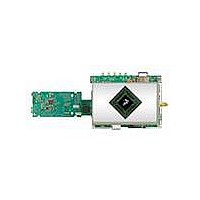MCIMX35WPDKJ Freescale Semiconductor, MCIMX35WPDKJ Datasheet - Page 76

MCIMX35WPDKJ
Manufacturer Part Number
MCIMX35WPDKJ
Description
BOARD DEV FOR I.MX35
Manufacturer
Freescale Semiconductor
Series
i.MX35r
Type
MPUr
Datasheets
1.MCIMX35WPDKJ.pdf
(148 pages)
2.MCIMX35WPDKJ.pdf
(2 pages)
3.MCIMX35WPDKJ.pdf
(10 pages)
Specifications of MCIMX35WPDKJ
Contents
Module and Misc Hardware
Processor To Be Evaluated
i.MX35
Processor Series
i.MX35
Data Bus Width
32 bit
Interface Type
RS-232, Ethernet, USB, CAN, JTAG
Core
ARM11
For Use With/related Products
i.MX35
Lead Free Status / RoHS Status
Lead free / RoHS Compliant
- Current page: 76 of 148
- Download datasheet (3Mb)
4.9.13.3.7
The timing characteristics of the TV encoder interface are identical to the synchronous display
characteristics. See
Characteristics.”
4.9.13.4
This section discusses the asynchronous parallel and serial interfaces.
4.9.13.4.8
The IPU supports the following asynchronous parallel interfaces:
For each of four system interfaces, there are three burst modes:
Both system 80 and system 68k interfaces are supported for all described modes as depicted in
Figure
DISPB_Dn_WR and DISPB_Dn_RD signals.
76
•
•
1. Burst mode without a separate clock—The burst length is defined by the corresponding parameters
2. Burst mode with the separate clock DISPB_BCLK—In this mode, data is sampled with the
3. Single access mode—In this mode, slave AHB and DMA burst are broken to single accesses. The
55,
System 80 interface
— Type 1 (sampling with the chip select signal) with and without byte enable signals.
— Type 2 (sampling with the read and write signals) with and without byte enable signals.
System 68k interface
— Type 1 (sampling with the chip select signal) with or without byte enable signals.
— Type 2 (sampling with the read and write signals) with or without byte enable signals.
of the IDMAC (when data is transferred from the system memory) or by the HBURST signal
(when the MCU directly accesses the display via the slave AHB bus). For system 80 and system
68k type 1 interfaces, data is sampled by the CS signal and other control signals change only when
transfer direction is changed during the burst. For type 2 interfaces, data is sampled by the WR/RD
signals (system 80) or by the ENABLE signal (system 68k), and the CS signal stays active during
the whole burst.
DISPB_BCLK clock. The CS signal stays active during whole burst transfer. Other controls are
changed simultaneously with data when the bus state (read, write or wait) is altered. The CS
signals and other controls move to non-active state after burst has been completed.
data is sampled with CS or other controls according to the interface type as described above. All
controls (including CS) become non-active for one display interface clock after each access. This
mode corresponds to the ATI single access mode.
Figure
Asynchronous Interfaces
Interface to a TV Encoder, Electrical Characteristics
Parallel Interfaces, Functional Description
56, and
i.MX35 Applications Processors for Industrial and Consumer Products, Rev. 9
Section 4.9.13.1.5, “Interface to Active Matrix TFT LCD Panels, Electrical
Figure
57. These timing images correspond to active-low DISPB_Dn_CS,
Freescale Semiconductor
Figure
54,
Related parts for MCIMX35WPDKJ
Image
Part Number
Description
Manufacturer
Datasheet
Request
R
Part Number:
Description:
MCIMX-LVDS1
Manufacturer:
Freescale Semiconductor
Datasheet:
Part Number:
Description:
Manufacturer:
Freescale Semiconductor, Inc
Datasheet:
Part Number:
Description:
Manufacturer:
Freescale Semiconductor, Inc
Datasheet:
Part Number:
Description:
Manufacturer:
Freescale Semiconductor, Inc
Datasheet:
Part Number:
Description:
Manufacturer:
Freescale Semiconductor, Inc
Datasheet:
Part Number:
Description:
Manufacturer:
Freescale Semiconductor, Inc
Datasheet:
Part Number:
Description:
Manufacturer:
Freescale Semiconductor, Inc
Datasheet:
Part Number:
Description:
Manufacturer:
Freescale Semiconductor, Inc
Datasheet:
Part Number:
Description:
Manufacturer:
Freescale Semiconductor, Inc
Datasheet:
Part Number:
Description:
Manufacturer:
Freescale Semiconductor, Inc
Datasheet:
Part Number:
Description:
Manufacturer:
Freescale Semiconductor, Inc
Datasheet:
Part Number:
Description:
Manufacturer:
Freescale Semiconductor, Inc
Datasheet:
Part Number:
Description:
Manufacturer:
Freescale Semiconductor, Inc
Datasheet:
Part Number:
Description:
Manufacturer:
Freescale Semiconductor, Inc
Datasheet:
Part Number:
Description:
Manufacturer:
Freescale Semiconductor, Inc
Datasheet:










